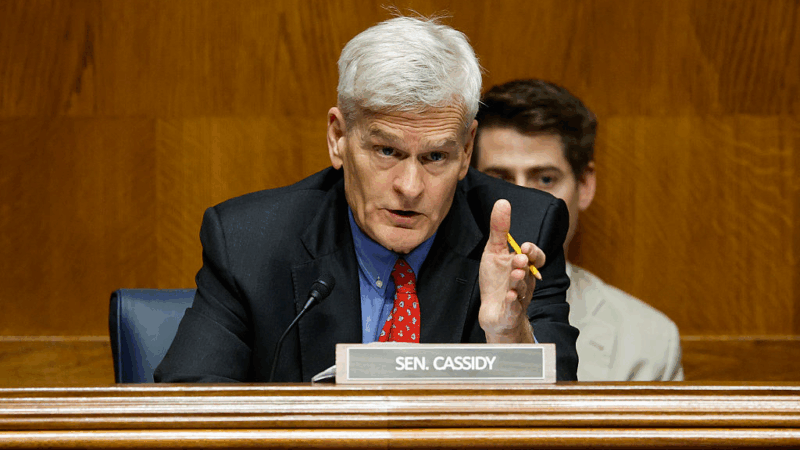Supreme Court allows Trump to resume mass federal layoffs for now
The Supreme Court on Tuesday lifted a lower court order that had blocked President Trump’s executive order requiring government agencies to lay off hundreds of thousands of federal employees.
The order was unsigned. Justice Ketanji Brown Jackson, who was appointed to the court by President Biden, dissented. Justice Sonia Sotomayor, a fellow liberal, concurred with the court’s decision. The order did not make clear how the other justices voted, but they did say, “we express no view on the legality of any” plans to shrink the federal workforce, and it left open the possibility that the issue could return to the Supreme Court.
Justice Sotomayor, in her concurrence, wrote that the lower courts were free to address the constitutionality of the plans.
“The plans themselves are not before this Court, at this stage, and we thus have no occasion to consider whether they can and will be carried out consistent with the constraints of law,” she wrote.
In her dissent, Justice Jackson suggested the court was allowing the administration to remake the federal judiciary before the courts had had a chance to determine their legality.
“For some reason, this Court sees fit to step in now and release the President’s wrecking ball at the outset of this litigation,” she wrote. “In my view, this decision is not only truly unfortunate but also hubristic and senseless.”
In February, Trump detailed an extensive plan instructing agency heads to prepare for “large-scale reductions in force,” known as RIFs.
Later that month, the administration issued an accompanying memorandum alleging that the federal government is “costly, inefficient and deeply in debt,” and blaming that inefficiency on “unproductive and unnecessary programs that benefit radical interest groups.” The memo required agency heads to submit initial layoff plans to the Office of Management and Budget and the U.S. Office of Personnel Management two weeks later.
The executive order and memorandum included explicit tools for staff reduction including a general standard that no more than one employee should be hired for every four employees that depart, removing underperforming employees, and allowing term or temporary positions to expire without renewal.
Groups challenging the layoffs in court contend that the RIFs could result in “hundreds of thousands of federal employees los[ing] their jobs.” They argued that without the temporary restraint “there w[ould] be no way to unscramble the egg” if they eventually won the larger case in the lower court. They contended that without the temporary block to the federal layoffs, “critical government services would be lost … there [would] be no way to go back in time to restore those agencies, functions, and services.”
Labor unions, advocacy groups and local governments sued the president and 21 federal agencies over the RIFs, contending that the president exceeded his authority in mandating the federal layoffs. They argued that the president avoided the congressional approval needed to restructure federal agencies.
During his first term, Trump sought congressional approval to mandate similar layoffs. But, Congress rejected his plan. This time Trump didn’t bother going to Congress, and objectors sued, arguing that to implement the RIF plan legally, the administration should have sought congressional approval or “cooperate[d] with Congress through the regular legislative or budgetary process.”
The administration contends that the president has the authority to conduct mass layoffs on his own. As the executive, they argue, “the President does not need additional statutory authorization to direct agencies to conduct RIFs to further reorganizations.”
U.S. District Judge Susan Illston, a federal district court judge in California, disagreed, temporarily blocking the administration from mandating mass agency-wide layoffs while lower court proceedings continue.
Illston, a Clinton appointee, also blocked a subsequent OMB and OPM memo telling agencies how to carry out Trump’s executive order.
Illston’s decision stopped most of the government’s largest agencies from issuing new reorganization plans and layoff notices. It also prevented those agencies from formally separating those who have already received such notices and are currently on administrative leave.
The 9th Circuit Court of Appeals has since agreed with the lower court, concluding that because the order is temporary, it isn’t too heavy a burden on the administration’s actions.
In seeking to unblock the lower court order, the administration said that the lower court had joined “the parade of courts entering improper universal injunctions.” When a federal judge issues a universal injunction, he or she not only stops the government’s action in their region but throughout the entire country — hence, the lower court halted Trump’s executive order not only in California but across the U.S.
This isn’t the first time that the Trump administration has appealed to the Supreme Court contesting universal injunctions. In May, the high court considered whether federal district courts could use the tactic to block Trump’s executive order overturning birthright citizenship. It has taken the same position in almost every case involving such injunctions.
On Tuesday, as it has done with most of these cases, the court sided with the Trump administration and allowed the president to resume plans for mass federal layoffs.
In a statement, Harrison Fields, a White House spokesman, called the court’s decision “another definitive victory for the President and his administration.”
“It clearly rebukes the continued assaults on the President’s constitutionally authorized executive powers by leftist judges who are trying to prevent the President from achieving government efficiency across the federal government,” he said.
The American Federation of Government Employees, the labor union that represents federal workers, and its coalition that sued the administration called the decision “a serious blow to our democracy.”
“This decision does not change the simple and clear fact that reorganizing government functions and laying off federal workers en masse haphazardly without any congressional approval is not allowed by our Constitution,” the coalition said in a statement. “While we are disappointed in this decision, we will continue to fight on behalf of the communities we represent and argue this case to protect critical public services that we rely on to stay safe and healthy.”
After Texas ruling, Trump and Republicans head to 2026 with a redistricting edge
Trump has prompted a redistricting race as he tries to maintain Republican control of the House in the 2026 elections. Democrats have fewer options to counter, as the battle heads into next year.
How China, not the U.S., became the main climate solution story in 2025
The U.S. has become a "side character" in the global story of renewable energy, experts say. China dominates the sector, with positive implications for the climate and their economy.
Supreme Court to hear case that could vastly expand presidential powers
The Supreme Court hears arguments in a case about President Trump's firing of a Federal Trade Commissioner. At stake is a 90-year precedent limiting the president's power over independent agencies.
Republicans push high deductible plans and health savings accounts
A Republican call to give Americans cash instead of health insurance subsidies revives an old idea that has left millions with medical debt.
Zelenskyy heads to London for more Ukraine peace talks. Here’s what to know
The talks signal fresh support from European allies. But they follow stalled U.S. negotiations in Miami and comments from President Trump's son suggesting Washington is ready to pull back.
Tributes, not politics, play center stage as Trump hosts the Kennedy Center Honors
President Trump said he was closely involved with picking the honorees, and on Sunday he became the first president to host the Kennedy Center awards ceremony.








